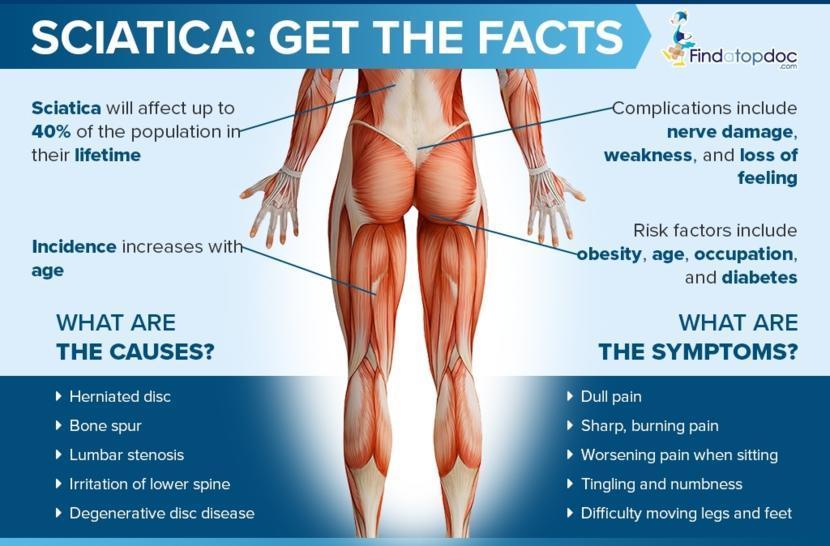What Is Sciatica?

What is sciatica?
Lower back pain is a very common condition that is often incorrectly managed. Back pain is a challenge in itself since it demands medical support and is a leading source of social, psychological, and physical disabilities. The majority of back pains are self-limiting and simple, although it is crucial for you to understand which ones are not.
Sciatica is a symptom and not a condition by itself. It refers to the pain that starts in your buttocks and hips and radiates to the leg. Mostly, sciatica comes together with back pain, which can be less or more serious compared to leg pain. For a person with sciatica, the sciatic nerve that runs from the lower back via the buttocks and into the leg is the source of pain.
True sciatica develops when an osteoarthritic bone spur or a herniated disc puts pressure on and pinches the sciatic nerve roots. This is what is referred to as a pinched nerve. This form of lower back pain is not as common as other disorders or sources that lead to back pain. For example, recreational activities, sports, and heavy manual work can result in leg and back pain, which are frequently misdiagnosed as sciatica. It can be hard to differentiate between referred pain, which results from musculoskeletal strain or sprain, and radiculopathy (also known as radicular pain) that results from a nerve root that has been inflamed.
Radiculopathy
The word "radiculopathy" is used to particularly explain pain and other symptoms such as tingling, numbness, and weakness in the legs or arms resulting from a complication in the nerve roots. Branches of the spinal cord and nerve roots transport signals to the entire body along the spine. It is derived from the Latin word "radix", meaning "roots of a tree", and "pathos", which means "disease".
This condition is mostly as a result of direct pressure from degenerative alterations in the lumbar spine or a herniated disc that causes inflammation and irritation of the nerve roots. Normally, radiculopathy will form a pain pattern and numbness in your legs and arms in the section of skin supplied by sensory fibers found in the nerve root and weakness of the muscles supplied by the similar nerve root.
Herniated disc
Herniation means an irregularity of the intervertebral disc. It is also referred to as a ruptured, bulging, or torn disc. A herniated disc takes place when the nucleus pulposus, which is the inner core of the intervertebral disc bulges out via the annulus fibrosus or the external coating of ligaments that encircle the disc.
As a result of the tear in the annulus fibrosus, you will experience back pain at the place of herniation. If the disc that is sticking out puts pressure on a spinal nerve, the pain may radiate to the part of your body that is connected to that nerve. There is a pair of spinal nerves between every vertebra, which subdivides from the spinal cord to a particular part of your body. The majority of disc ruptures take place when individuals are in their thirties or forties when their nucleus pulposus still resembles gelatin.
Facts About Sciatica
- Sciatica is the pain resulting from the irritation of the sciatic nerve.
- The sciatic nerve is the body’s largest nerve.
- Normally, sciatica begins in the lower back before spreading to the rear of the thigh and below the knee.
- Sciatica treatments are determined by pain severity and the primary cause of pain.
Symptoms of Sciatica
The common symptoms of sciatica include:
- Lower back pain
- Pain in the leg or back that worsens when you sit down
- Pain in the hips
- Tingling or burning sensations in the legs
- Numbness, weakness, or problems moving your foot or leg
- A persistent pain on one side of your back
- A piercing pain that makes standing up difficult
Normally, sciatica will affect only one side of your lower body. The pain mostly radiates from the lower back all the way down the rear thigh and down your leg. The pain may also spread to your toes or foot, depending on the area where the sciatic nerve is affected.
In some cases, pain resulting from sciatica can be serious and unbearable. If you experience continuous weakness in the lower leg, loss of bowel or bladder control, or numbness in the upper thighs, consult your doctor immediately.
Causes of Sciatica
A slipped disc is what causes the majority of sciatica cases. A slipped disc takes place when one of the discs that are found in the vertebra is damaged, putting pressure on the nerves.
What causes the damage is still not known, but as you age, your discs become less flexible and have higher chances of rupturing.
The following are less common causes of sciatica:
- Spinal damage - caused by a spinal infection or injury
- Spinal stenosis - where the spine’s nerve pathways become narrow
- Spinal growth - a tumor that grows inside the spinal canal
- Spondylolisthesis - where a vertebra moves out of position
- Cauda equina syndrome - although uncommon, it is a severe condition resulting from damaged or compressed nerves in your spinal cord
Treatment for Sciatica
The majority of sciatica patients recover within 6 weeks without treatment. You may, however, minimize the symptoms by taking over-the-counter painkillers, using cold or hot packs, and exercising.
Additional treatment may be advised if you have constant sciatica. They may include:
- Receiving anti-inflammatory injections and painkillers via the spine.
- Enrolling in a structured exercise program, which is supervised by a physiotherapist.
- Although rare, surgery may be required to correct the complication in your spine.
Relieving sciatica pain by exercise
Compared to bed rest, exercise is more effective in relieving the pain associated with sciatica. After the sciatic pain flares up, you may rest for one or two days, but after that, being inactive will only worsen the pain.
If you fail to exercise, your spinal structures and back muscles will become deconditioned and lose their ability to support your back. As a result of the weakening and deconditioning, you may experience back strain and injury, which leads to even more pain. Movement assists in the exchange of fluids and nutrients in the discs to keep them healthy and keep off pressure on your sciatic nerve.
Prevention
Do the following activities to minimize the episodes of sciatica:
- Exercise frequently
- Stretch before and after you exercise
- Implement good posture and lifting techniques
The mattress you sleep on should be firm enough to support your body as it supports your buttocks and shoulders’ weight. You also have to make sure that your spine is straight. Place a firm board below your mattress if it is too soft. Use a pillow to support your head. However, your pillow should not be inclined at a vertical angle.
Risk Factors for Sciatica
Sciatica or lower back pain (LBP) is more frequent in developed societies. Women and men are equally affected, although, in those aged over 60 years, women experience LBP symptoms more compared to men. LBP is at its peak during the middle ages and decreases in old age, when degenerative alterations of the spine are common. Normally, sciatica will develop in people in the fourth and fifth decades of their lives. According to research, risk factors such as smoking and obesity may make one more susceptible to back pain.
Back disability may be influenced by work conditions, social and legal factors, job dissatisfaction, emotional circumstances, and financial stressors. Although the majority of experts conclude that lifting, long-term static work postures, heavy physical work, exposure to vibration, and simultaneous twisting and bending can lead to sciatica, such causes are still not medically supported.
When to visit your doctor
You should visit your doctor if your symptoms become persistent, severe, or have worsened. Based on your symptoms, the doctor may perform a physical examination and determine an appropriate method of treatment. The passive straight leg raise, which is a simple test, may assist your doctor in determining whether you have sciatica or not.
During this test, you will lie flat on your back while straightening your legs, and simultaneously lift the legs. You probably have sciatica if lifting one of the legs results in pain or worsens your symptoms.
Immediately call for an emergency if you develop the following:
- Numbness or tingling in the legs and buttocks
- Sciatica in both legs
- Loss of bowel or bladder control
These symptoms may be indicators of cauda equina syndrome (CES), which is a rare, but severe condition.












